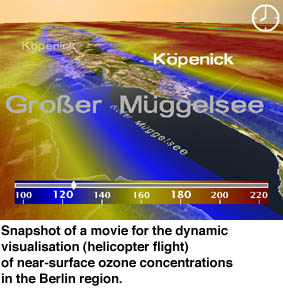Dynamic Models for Smog Analysis
by Achim Sydow, Thomas Lux, Peter Mieth, Matthias Schmidt and Steffen
Unger
The project DYMOS (Dynamic Models for Smog Analysis) carried out at GMD Institute for Computer Architecture and Software Technology, Berlin, is concerned with the development and pilot application of simulation systems and models for air pollution and vehicular traffic, running on High Performance Computing platforms. The aim is to support users in governmental administrations and industry in operative decision making as well as long-term planning, to serve as a scientific basis for national or international negotiations, and to enable predictions (air pollutants concentration, traffic density, etc.) for informing the public (WWW, TV, radio).
The DYMOS system is a parallelly implemented air pollution simulation system for mesoscale applications. DYMOS consists of different meteorology/transport models for different application purposes including an air chemistry model for the calculation of photochemical oxidants like ozone.
The core of the model system is formed by a hydrostatic mesoscale Eulerian model with a low vertical resolution for fast operational forecast tasks (enhanced version of REWIMET/REgional WInd Model Encompassing Transport) and a non-hydrostatic mesoscale Eulerian model with a high vertical resolution and complex parameterization facilities (enhanced version of GESIMA/ GEesthacht SImulation Model of the Atmosphere). In addition, some Eulerian and Lagrangian transport models are included within DYMOS. The air chemistry model CBM-IV (Carbon Bond Mechanism) is dealing with 34 species in 82 reaction equations for simulating the photochemical processes in the lower atmosphere.
Using the DYMOS system, analyses can be performed regarding winter smog (high concentrations of inert pollutants), summer smog (high concentrations of ozone and other photochemical oxidants), and single components (eg heavy metals, benzol, radioactive or antigenic substances). In addition to providing a dynamic emission source for the smog forecast simulations, traffic flow modelling has become a research field within DYMOS in its own right. Emphasis is put on the analysis of critical states in urban traffic systems. Due to the research work with basic character carried out in DYMOS, a foundation has been set for further, more applied projects.
DYMOS Applications
Various case studies of summer smog conditions in urban areas have been carried out using the DYMOS system. The Department of the Environment of the Berlin state government and the Ministry for Environment of the state Brandenburg commissioned summer smog analyses for the results of a measuring campaign carried out in July 1994. Greenpeace commissioned an analysis of the influence of emissions caused by traffic in Munich on the ozone concentration in the Munich area. The analysis was performed for a typical mid-summer day in 1994. Within the subproject PATRIC (Parallel Petri-Net Simulation for Traffic Control in Conurbations) the DYMOS system coupled with an Petri-net-based traffic flow model was used to analyze the traffic induced air pollution of the City of Budapest.
 In order to inform the public about ozone concentrations,
the DYMOS system is currently in its test phase for the operational daily
forecast of near surface ozone concentrations in the Berlin-Brandenburg
region. In cooperation with the Department of the Environment of the Berlin
state government, the German Federal Environmental Agency and Inforadio
Berlin, the predicted concentrations are presented as raster images for
defined day times and as MPEG movie (see figure) for the whole day and
can be found on the WWW (http://www.first.gmd.de/ozon/).
In order to inform the public about ozone concentrations,
the DYMOS system is currently in its test phase for the operational daily
forecast of near surface ozone concentrations in the Berlin-Brandenburg
region. In cooperation with the Department of the Environment of the Berlin
state government, the German Federal Environmental Agency and Inforadio
Berlin, the predicted concentrations are presented as raster images for
defined day times and as MPEG movie (see figure) for the whole day and
can be found on the WWW (http://www.first.gmd.de/ozon/).
The research activities within DYMOS have given rise to a number of direct subprojects and three autonomous European cooperation projects based on DYMOS: ECOSIM/ Ecological and environmental monitoring and simulation system for management decision support in urban areas (see article in this issue), HITERM/High-Performance Computing and Networking for Technological and Environmental Risk Management (see article in this issue) and SIMTRAP/HPCN Simulation of Traffic Induced Air Pollution Using Parallel Computing in a Distributed Network (see article in this issue). More information about the DYMOS project is available at http://www.first.gmd.de/applications/proj/dymos_more.html
Please contact:
Achim Sydow - GMD
Tel: +49 30 6392 1813
E-mail: sydow@first.gmd.de
